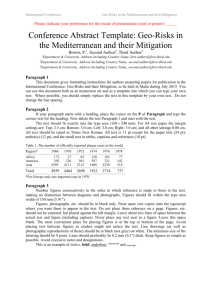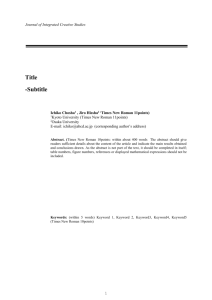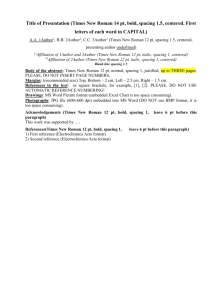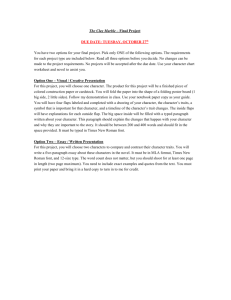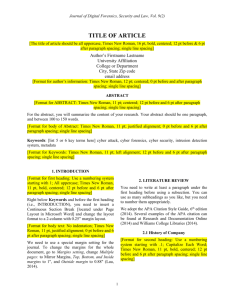Yogyakarta, 22-23 January 2014 Proceedings of the 1st AUN/SEED
advertisement
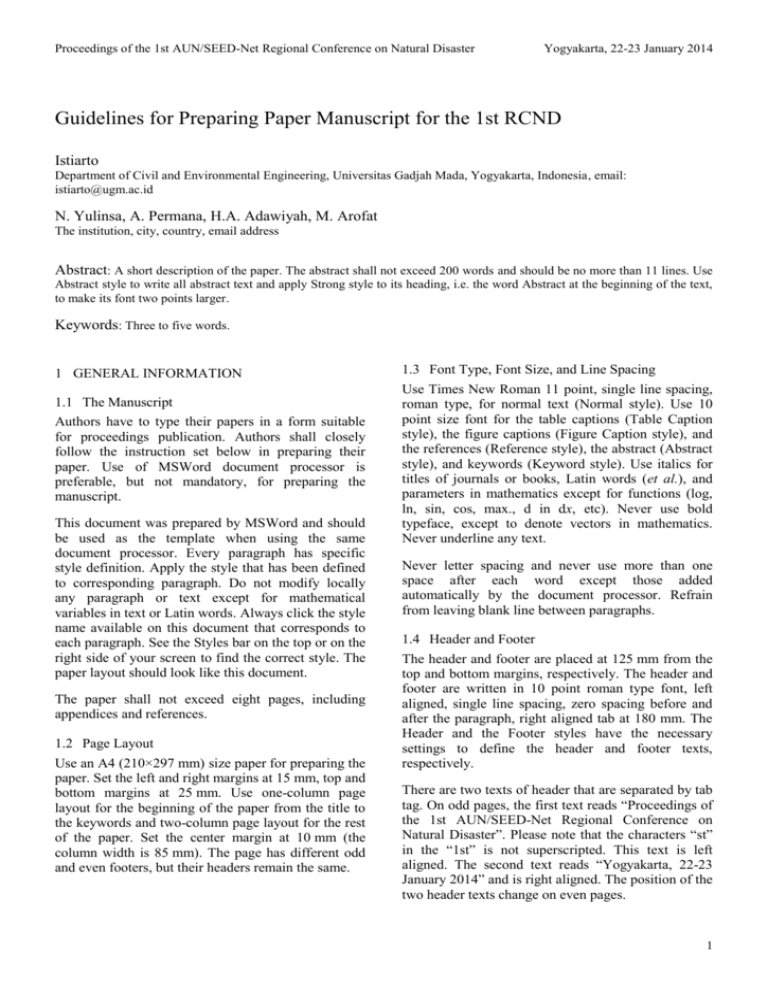
Proceedings of the 1st AUN/SEED-Net Regional Conference on Natural Disaster Yogyakarta, 22-23 January 2014 Guidelines for Preparing Paper Manuscript for the 1st RCND Istiarto Department of Civil and Environmental Engineering, Universitas Gadjah Mada, Yogyakarta, Indonesia, email: istiarto@ugm.ac.id N. Yulinsa, A. Permana, H.A. Adawiyah, M. Arofat The institution, city, country, email address Abstract: A short description of the paper. The abstract shall not exceed 200 words and should be no more than 11 lines. Use Abstract style to write all abstract text and apply Strong style to its heading, i.e. the word Abstract at the beginning of the text, to make its font two points larger. Keywords: Three to five words. 1 GENERAL INFORMATION 1.1 The Manuscript Authors have to type their papers in a form suitable for proceedings publication. Authors shall closely follow the instruction set below in preparing their paper. Use of MSWord document processor is preferable, but not mandatory, for preparing the manuscript. This document was prepared by MSWord and should be used as the template when using the same document processor. Every paragraph has specific style definition. Apply the style that has been defined to corresponding paragraph. Do not modify locally any paragraph or text except for mathematical variables in text or Latin words. Always click the style name available on this document that corresponds to each paragraph. See the Styles bar on the top or on the right side of your screen to find the correct style. The paper layout should look like this document. The paper shall not exceed eight pages, including appendices and references. 1.2 Page Layout Use an A4 (210×297 mm) size paper for preparing the paper. Set the left and right margins at 15 mm, top and bottom margins at 25 mm. Use one-column page layout for the beginning of the paper from the title to the keywords and two-column page layout for the rest of the paper. Set the center margin at 10 mm (the column width is 85 mm). The page has different odd and even footers, but their headers remain the same. 1.3 Font Type, Font Size, and Line Spacing Use Times New Roman 11 point, single line spacing, roman type, for normal text (Normal style). Use 10 point size font for the table captions (Table Caption style), the figure captions (Figure Caption style), and the references (Reference style), the abstract (Abstract style), and keywords (Keyword style). Use italics for titles of journals or books, Latin words (et al.), and parameters in mathematics except for functions (log, ln, sin, cos, max., d in dx, etc). Never use bold typeface, except to denote vectors in mathematics. Never underline any text. Never letter spacing and never use more than one space after each word except those added automatically by the document processor. Refrain from leaving blank line between paragraphs. 1.4 Header and Footer The header and footer are placed at 125 mm from the top and bottom margins, respectively. The header and footer are written in 10 point roman type font, left aligned, single line spacing, zero spacing before and after the paragraph, right aligned tab at 180 mm. The Header and the Footer styles have the necessary settings to define the header and footer texts, respectively. There are two texts of header that are separated by tab tag. On odd pages, the first text reads “Proceedings of the 1st AUN/SEED-Net Regional Conference on Natural Disaster”. Please note that the characters “st” in the “1st” is not superscripted. This text is left aligned. The second text reads “Yogyakarta, 22-23 January 2014” and is right aligned. The position of the two header texts change on even pages. 1 Yogyakarta, 22-23 January 2014 Proceedings of the 1st AUN/SEED-Net Regional Conference on Natural Disaster Apply Header style to the header texts. Apply Footer style to the footer text. Apply Abstract style to the paragraph. It defines the abstract paragraph as 10 point roman type, justified alignment, single line spacing, 20 point spacing before and 10 point spacing after the paragraph. Select its heading including the colon (the word “Abstract:”) and apply Strong style to make its font size two points larger. 1.5 File Name Authors shall submit their papers in two file formats, in pdf format and in its original format. Name both files according to the following: «name of conference» «name of first author» «title of paper in six or less words». Do not modify the file extension; leave it as is put by the document processor (.pdf, .doc, .docx). Examples of correct file name are: 2.4 Keywords Write 3 to 5 key words separated by coma. Apply Keyword style to the paragraph. It defines the keywords paragraph as 10 point roman type, left aligned, single line spacing, zero spacing before and after the paragraph. Select its heading including the colon (the word “Keywords:”) and apply Strong style to make its font size two points larger. a) RCND Istiarto Flood Hazard Mapping.doc. b) RCND Istiarto Flood Hazard Mapping.docx. 2.5 Change of Layout You may leave the footer blank or you may put a page number on it. The page number is right aligned on odd pages and left aligned on even pages. Please notice that in most cases the operating system of the computer does not show the extension. 2 TEXT LAYOUT 2.1 Title Apply Title style to the paper’s title. This style has everything needed to define the title layout (font type and size, paragraph alignment, spacing). The title shall be 16 point roman type font, title case (capitalize first character of each text, except for preposition), left aligned, single line spacing, 20 point spacing before and after the paragraph. 2.2 Authors and Their Affiliation Type the name of the authors by their initials followed by their last name. Group the authors by their affiliation. If there is only one co-author and he/she has the same affiliation with that of the first author, put the word “and” to separate their names. Apply Author style to the author paragraph. The authors are written in 12 point roman type font, left aligned, single line spacing, zero spacing before and after the paragraph. Apply Author Affiliation style to the affiliation paragraph. The paragraph should be 10 point roman type, left aligned, single line spacing, zero spacing before and 10 point spacing after the paragraph. Author(s) affiliation should contain the following: company/institute/university, city, country. 2.3 Abstract Abstract shall not exceed 200 words and should be no more than 11 lines. 2 Give one blank line below keyword paragraph and apply Normal style to it. Insert a section break (a continuous one). This can be done by clicking Page Layout from the main menu, select Section Breaks Continuous from various break types on the window that appears. Apply two-column page layout with 10 mm center margin (the column width will be 85 mm). This document has already been set according to the above page layout. 2.6 Headings Use of two ranks of heading is preferable for the chapter and section. Apply Heading 1 and Heading 2 styles for the chapter and section headings, respectively. You may add a sub-section to have three ranks of heading and apply Heading 3 for this subsection. Headings shall be kept with the paragraph that immediately follows. The chapter heading is written in 11 point roman type font, single line spacing, 15 point spacing before and 4 point spacing after the paragraph. By applying Heading 1 style, an all capital character and an automatic numbering will be given to the chapter heading. The chapter heading is automatically kept with the paragraph that immediately follows. The section heading is written in 11 point roman type font, single line spacing, 12 point spacing before and 4 point spacing after the paragraph. By applying Heading 2 style, an automatic numbering will be given to the section heading. The section heading is automatically kept with the paragraph that immediately follows. Proceedings of the 1st AUN/SEED-Net Regional Conference on Natural Disaster Yogyakarta, 22-23 January 2014 It is strongly recommended to organize the paper in chapters and sections. In rare cases, the paper may have sub-section. However, the author should try to avoid having sub-section in his/her paper. The paragraph below is an example of a sub-section heading. dd/dx to express differential of d with respect to x. Do not use italic type font for unit. Type s instead of s for time unit in second. Type s for variable s, which you may define for distance. Type C for degree unit in Celsius, but type C for variable that you may define for concentration for example. 2.6.1 This is a sub-section heading Use bold characters to denote matrix or vector variables. The sub-section heading is written in 11 point roman type font, single line spacing, 10 point spacing before and 4 point spacing after the paragraph. An automatic numbering will be given when Heading 3 style is applied to the sub-section heading. 2.7 Text Apply Normal style to paragraphs of the text. It defines the paragraphs to be 11 point roman type font, justified alignment, single line spacing, zero point spacing before and 10 point spacing after the paragraph. Do not use blank paragraphs to get spacing between consecutive paragraphs. You may activate line hyphenation. This gives better paragraph format, but you will have to be careful that sentence is hyphenated correctly. Do not locally modify paragraph except to write mathematical parameters or symbols, Latin words, titles of journals or books. Use appropriate symbol for degree, which you may get by inserting degree sign from Symbol toolbar available in MSWord, for example 28°C. Do not use superscripted o for degree sign. Use multiplication sign × instead of x for multiplication. Give definition of variables below the equation where they appear for the first time. The equation paragraph is left aligned, single line spacing, zero point spacing before and 10 point spacing after the paragraph, do not add space between equation paragraphs. Apply Equation style to define equation paragraph. Number consecutively the equations according to their order of appearance. Place the number in parentheses; flush it to the right margin using tab key. Refer equations by these numbers. Equation (1) and Equation (2) are examples of putting equations in the text. Use numbering format to write lists. a) Use this type of numbering. b) It is done by applying paragraph numbering format that is available in MSWord. c) Do not indent the list. Numerals of five or more digits are grouped in threedigit blocks by spaces or commas, e.g. 10,000. Do not do that for numerals of four or less digits, e.g. 9000. Decimals are expressed by points, e.g. 3.141592654 or 3.141 592 654. Pay attention not to line break numerals. To keep space separated words on the same line, use non-hyphenated space. Press SPACEBAR while pressing CONTROL+SHIFT keys, i.e. press together the spacebar, control, and shift keys, to insert this non-hyphenated space. Use SI unit or its derivatives to denote units. 2.8 Equations Use equation editor for special high quality fonts for all mathematical equations in the text. Italic type font shall be used as variable except for Greek symbols. Type f but for variables Roman type font shall be used as function, e.g. sin, exp, log, d in dx, ∂ in ∂x. Do not type d when you mean differential. You may have A Q q 0 t x (1) where A is the cross-sectional area of flow, Q is the discharge, qℓ is the lateral flow per unit length of channel, t is the time, and x is the distance along the channel. du d d R dx dx dx (2) where u is the flow velocity, is a scalar variable, Γ is the diffusion coefficient, R is the source, and x is the distance along the flow. 2.9 Tables Tables should be located close to the first reference to them in the text and number them consecutively. Explanations should be given at the foot of the table, not within the table itself. Use only horizontal rules: One above and one below the column headings and one at the foot of the table. Tables are written in 11 point roman type font. You may use smaller font size (10 point) in tables. The table should fit within column width of 85 mm. 3 Yogyakarta, 22-23 January 2014 Proceedings of the 1st AUN/SEED-Net Regional Conference on Natural Disaster Apply Table Text style to all table texts and column headings. Align column headings to the left of their column and start these headings with an initial capital. Column headings are vertically centered, single line spacing. Align all table texts to the left of their column and to the top of their row. Table texts are single line spacing, zero point spacing before and after the paragraph. Type table’s caption above the table. Use 10 point roman type font, left aligned, single line spacing, 15 point spacing before and 4 point spacing after the paragraph, keep together with the table. Do not put a full stop (“.”) at the end of the caption. Apply Table Caption style to the table caption. See for example Table 1. You may have two-column wide tables. For such cases, place the tables in a one-column page layout. Try to place a two-column wide table on top or bottom of a page. Place a column break before and after the tables and set the page layout accordingly. The table should fit within the type area width of 180 mm. Table 2 shows an example of wide table placement. Table 1. Names of styles used in the paper manuscript Styles Abstract Author Author Affiliation Equation Figure Figure Caption Footer Header Heading 1 Heading 2 Heading 3 Heading Not-numbered Keyword List Paragraph Normal Strong Table Caption Table Text Title Uses Abstract Authors Authors’ affiliation Equations Figures Caption of figures Footer Header Chapter heading Section heading Sub-section heading Heading for acknowledgment, references, appendices Keywords Numbered lists Text Heading of the abstract and of the Keywords Caption of tables Texts in tables Title of the paper 2.10 Figures Figures should be located close to the first reference to them in the text and number them consecutively. Do not make distinction between photographs and diagrams. Figures should fit within one column width 4 of 85 mm or within the type area width of 180 mm. Figures, including photographs, shall be in black only. It is preferable to format figures as picture. When figures are edited directly in the text, place them in a drawing canvas. Do not place drawing objects on spaces created by inserting blank lines. Set the wrapping style of figures to “in line with text”. You find this option by right-clicking the drawing canvas or the figure, select format figures or drawing canvas, and select the appropriate wrapping style on the window that appears. Apply Figure style to the figure paragraph. This ensures that figures will have correct spacing between paragraphs. Place the figure caption underneath the figure. Apply Figure Caption style to the figure caption. The caption is written in 10 point roman type font, left aligned, single line spacing, 4 point spacing before and 15 point spacing after the paragraph. Put a full stop (“.”) at the end of the caption. Figure 1 gives an example of figure pasted from a jpg file, whereas Figure 2 is an example of figure made by inserting shapes directly on a drawing canvas. Place wide figures in a one-column page layout. Try to place them on top or bottom of page. Place a column break before and after the figures and set the page layout accordingly. The figures should fit within the type area width of 180 mm. Apply Figure style to the paragraph. Add caption underneath the figure and apply Figure Caption style. Example of this type is given by Figure 3. Figure 1. Example of figure pasted into the paper from a jpg file. Set the wrapping style as in line with text. Proceedings of the 1st AUN/SEED-Net Regional Conference on Natural Disaster Yogyakarta, 22-23 January 2014 Figure 2. Example of figure edited directly on a drawing canvas. a b d c Table 2. Maximum concentration of NOx for the simple terrain scenario Maximum concentration Indonesian NAAQS* Distance to maximum (μg/m3) (μg/m3) (μg/m3) 1-hour concentration 15.090 400 951 24-hour concentration 6.036 150 951 Annual concentration 1.207 100 951 * The Government Decree No. 41, May 26, 1999 concerning the National Ambient Level Standard of Air Pollutant. 1.8 Observed 1.6 Predicted 1.4 Water level (m) 1.2 1.0 0.8 0.6 0.4 0.2 Residue 0.0 -0.2 19-Dec-10 22-Dec-10 25-Dec-10 28-Dec-10 31-Dec-10 3-Jan-11 Figure 3. Example of wide figure. It has to fit within type area width of 180 mm. 3 CONCLUSIONS ACKNOWLEDGMENTS Conclusions should state concisely the most important propositions of the paper as well as the author’s view of the practical implications of the results. You may place your acknowledgments here. Write only essential acknowledgments. Apply Heading Not-numbered style to the heading of this acknowledgment. 5 Yogyakarta, 22-23 January 2014 Proceedings of the 1st AUN/SEED-Net Regional Conference on Natural Disaster REFERENCES Every text citation must be listed under the heading “References” at the end of the text. Conversely, all entries in the reference list must be cited in the text; those are not cited must not appear in the list. Apply Heading Not-numbered style to the heading of this reference. Below are examples of how to write references: journal, book, dissertation, and proceeding. Ahmed, F., and Rajaratnam, N. (1998). “Flow around bridge piers.” ASCE, J. Hydr. Engrg., 124(3), 288300. Graf, W.H., and Altinakar, M.S. (1998). Fluvial Hydraulics, John Wiley & Sons, Ltd., Chichester, England. Istiarto, I. (2001). “Flow around a cylinder on a scoured channel bed.” Ph.D. Thesis No. 2368, EPFL, Lausanne, Switzerland. Kobayashi, T., Aibara, T., and Harada, H. (1997). “Vorticity distribution of horseshoe vortex on scoured bed.” Proc. 27th Congress of the IAHR, San Francisco, California, Theme A, 202-207. APPENDICES Appendix(es) can be included here if necessary. If there are two or more appendices, use the headings as Appendix 1, Appendix 2. Apply Heading Not-numbered style to the heading of this chapter. 6
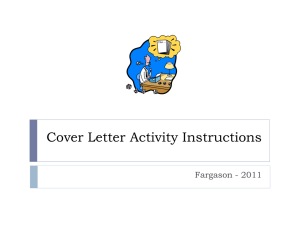
![Your Abstract Title Should Go Here [Title_bold] John C. Walk1,2](http://s3.studylib.net/store/data/006966397_1-005bd0551aa984e2218dee55c9fddb1c-300x300.png)
